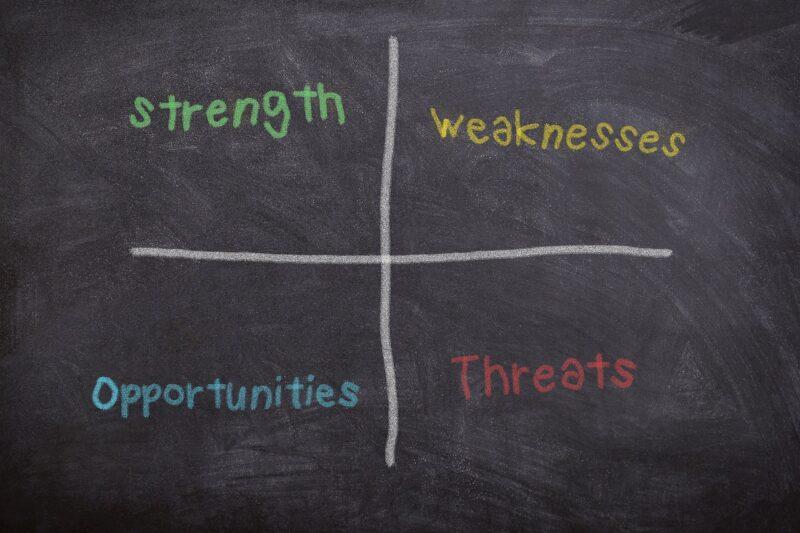I have been reflecting on the continued relevance of SWOT (strengths, weaknesses, opportunities, and threats) analysis as a critical element of strategic planning.
The SWOT analysis was invented in the 1960s by a management consultant named Albert Humphrey at the Stanford Research Institute to optimize environmental scanning to aid the development of long-term plans.
A lot has changed since the 60’s.
Our language has shifted from long-term planning to strategic planning or even strategic intent. The external environment has shifted from relatively stable to highly disruptive and dynamic. The assumption that you could create a strategic plan that would last for 3-5 years has shifted to annual updates and ongoing revisions to strategy. I am beginning to think that SWOT no longer fits our organizations’ environment today. If we examine the deep background assumptions embedded in SWOT, we can see some of the reasons why it may be a technique that has lost its effectiveness.
The SWOT analysis was based on the assumption that we could take a snapshot of the external environment and use it as a basis to develop strategic initiatives and goals for the next 3-5 years. Today, the external environment can shift so fast that even annual goals can shift priorities within three months of being written. The disruptive and volatile nature of the external environment can create opportunities that we couldn’t predict when we generated annual goals, as well as complete shifts in priorities, as new challenges or crises appear. The information changes – and so do our priorities.
Seven Generations of Thought
An alternative to SWOT is another older practice that comes from the Iroquois Nation called Seventh Generation stewardship. This concept integrates long-term decision-making into our daily leadership practices. Seventh Generation thinking urges the current generation of humans to live and work for the benefit of the seventh generation into the future. It originated with the Iroquois – Great Law of the Iroquois. The original language is as follows:
“In all of your deliberations in the Confederate Council, in your efforts at law making, in all your official acts, self-interest shall be cast into oblivion… Look and listen for the welfare of the whole people and have always in view not only the past and present but also the coming generations, even those whose faces are yet beneath the surface of the ground – the unborn of the future Nation.”
I think an innovative approach to a SWOT analysis would be to use a variation of seventh generation thinking. In this variation, we would have seven generations, with us in the 4th generation with three previous generations before us and three generations after us.
We would then build a reflective practice to capture our organization’s past decisions that are being harvested today (both the positive and negative unintended consequences). We would consciously learn from these reflections and use them to inform our decisions going forward into the next three generations. This kind of ongoing learning practice can help us pace the interdependence and dynamic nature of the external environment.
Time Delays in Living Systems
In complex systems, there are always time delays between the decision or action and ongoing consequences of that decision. For example, I have a lot of oak trees in my yard. The acorns drop in the fall and in the spring, I find them taking root in my gardens. At first, there is nothing to see because the roots are growing under the soil. Over the spring, the tree continues to grow and eventually, I see a leaf sprouting above the ground. This sprout continues to grow and will take decades before it becomes a mature tree, filling my yard with shade and more acorns.
The effect of having an oak tree in a place in my yard will continue to unfold. Any growing system is filled with time delays. In organizations, the way we make decisions can increase trust or diminish it. When leaders need trust to move a difficult decision forward, it won’t be there if we use processes that make people less trusting of those in leadership positions. In living organizations, the processes we use will also shape our future, even if we don’t see it immediately – just like the time it takes to grow an oak tree.
Seventh Generation thinking helps us consider the natural time delays that occur in an interdependent complex system. Currently, our organizations don’t do this very well. The focus on quarterly profits keeps us anchored in the present. We need to become more sophisticated at understanding and seeing time delays. For example, the time delay between the first release of a pollutant in the air and when we understand that it is causing health issues in the community can be decades.
Promoting Generations of Thinking in Your Organization
If we wanted to experiment with seventh generation thinking as a framework to continually understand what is happening in the external environment and inform ongoing strategy, we could try the following:
- Bring together multiple generations of employees for a focused conversation. A simple human timeline is an excellent way to uncover what was happening in the field 2-3 generations ago and what critical decisions happened at that time. In a human timeline, people stand in a line that goes from the most recent hires to those who have worked in the organization the longest. Then you separate the line into smaller groups based on 3-5-year time spans. Have each group respond to a set of questions that would reveal the culture of the organization and field in that time frame.
- What critical decisions were made?
- How have those decisions unfolded over time?
- Are there lessons we need to learn?
- As the reports are shared with the larger group, look for patterns of intended and unintended consequences that came from past decisions or assumptions about the field or external environments. Finally, collect the insights from this conversation and ask how these lessons need to influence our current decision-making.
- We could also incorporate multiple generation thinking capacities into our performance review process. By adding a reflective question in an annual review, we could focus each employee on seeing time delays that continue to unfold and impact their work. What decisions were made this year that hindered them or positioned the organization well or created an unforeseen problem?
I now think that seeing time and time delays is an essential and powerful way to be more strategic. We need to understand and see how actions and decisions from the past create the agenda of current problems and opportunities and how our decisions and the way we work with people today create problems and opportunities tomorrow.
What are some of your ideas that you are using or experimenting with that are designed to strengthen multiple generations thinking in your organization?
Dr. Kathleen E. Allen is the author of Leading from the Roots: Nature Inspired Leadership Lessons for Today’s World (available for pre-order on Amazon) and President of Allen and Associates, a consulting firm that specializes in leadership, innovation, and organizational change. www.kathleenallen.net
*References An Iroquois Perspective. Pp. 173, 174 in American Indian Environments: Ecological Issues in Native American History. Vecsey C, Venables RW (1980) (Editors). Syracuse University Press, New York.










I like this approach whatever generation it is, but there is still a key step missing, the one management is really looking for . . .Options.
Most SWOT analyses are conducted by staff people who see their job as finding the solution the boss needs.
Few staff people are equipped to find solutions anyway. Operators, however, on the firing line learn early in their careers that there are many was to solve problems so their search is always for options from which to choose or fashion a solution.
If all you provide from your SWOT is a path to one course of action, the report will gather dust as slowly as time will allow.
Time to adopt SWOOT.
Thank you for sharing this wise perspective to long term planning. I get very frustrated sitting through SWOT analysis sessions because the participants inevitability focus on the Threats and Weaknesses…many of those things are out of our control. It sucks the energy out of the process. Change comes when we focus on the Strengths and Opportunities…the things that can be controlled.
Very insightful comments on the very dated SWOT technique, great comparison to the 7th generation thinking! We need to continue to look to the old and most times reliable techniques in viewing the world.
The concept of envisioning our future selves may be key to this tactic. We often make poor decisions in the present because of the lack of relationship with our future selves. If we could envision ourselves in the future and how the decisions we make be them little or big will effect us we are much more likely to make decisions that would benefit us in the future. How can an organization envision itself and those it serves in the future to make better choices? Great stuff Kathy! The wheels, they are a-turning!